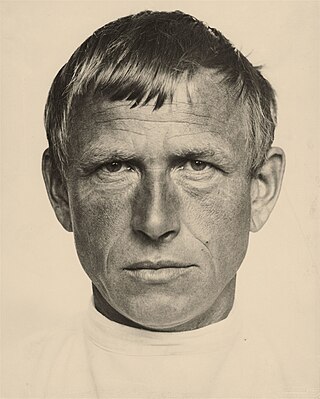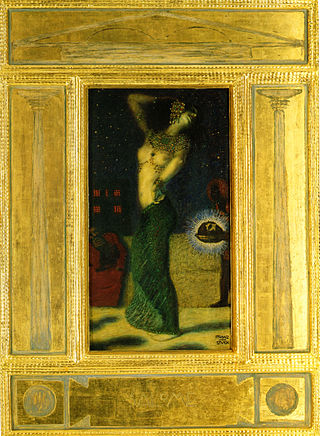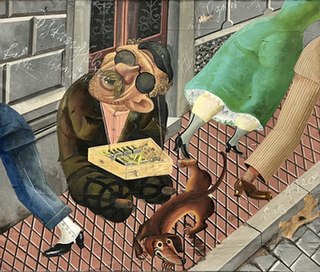Related Research Articles

Wilhelm Heinrich Otto Dix was a German painter and printmaker, noted for his ruthless and harshly realistic depictions of German society during the Weimar Republic and the brutality of war. Along with George Grosz and Max Beckmann, he is widely considered one of the most important artists of the Neue Sachlichkeit.

Degenerate art was a term adopted in the 1920s by the Nazi Party in Germany to describe modern art. During the dictatorship of Adolf Hitler, German modernist art, including many works of internationally renowned artists, was removed from state-owned museums and banned in Nazi Germany on the grounds that such art was an "insult to German feeling", un-German, Freemasonic, Jewish, or Communist in nature. Those identified as degenerate artists were subjected to sanctions that included being dismissed from teaching positions, being forbidden to exhibit or to sell their art, and in some cases being forbidden to produce art.

The New Objectivity was a movement in German art that arose during the 1920s as a reaction against expressionism. The term was coined by Gustav Friedrich Hartlaub, the director of the Kunsthalle in Mannheim, who used it as the title of an art exhibition staged in 1925 to showcase artists who were working in a post-expressionist spirit. As these artists—who included Max Beckmann, Otto Dix, George Grosz, Christian Schad, Rudolf Schlichter and Jeanne Mammen—rejected the self-involvement and romantic longings of the expressionists, Weimar intellectuals in general made a call to arms for public collaboration, engagement, and rejection of romantic idealism.

In art history, secession refers to a historic break between a group of avant-garde artists and conservative European standard-bearers of academic and official art in the late 19th and early 20th century. The name was first suggested by Georg Hirth (1841–1916), the editor and publisher of the influential German art magazine Jugend (Youth), which also went on to lend its name to the Jugendstil. His word choice emphasized the tumultuous rejection of legacy art while it was being reimagined.

Anita Berber was a German dancer, actress, and writer who was the subject of an Otto Dix painting. She lived during the time of the Weimar Republic.

Eldzier Cortor was an African-American artist and printmaker. His work typically features elongated nude figures in intimate settings, influenced by both traditional African art and European surrealism. Cortor is known for his style of realism that makes accurate depictions of poor, Black living conditions look fantastic as he distorts perspective.

Archibald John Motley, Jr., was an American visual artist. He studied painting at the School of the Art Institute of Chicago during the 1910s, graduating in 1918. Motley is most famous for his colorful chronicling of the African-American experience in Chicago during the 1920s and 1930s, and is considered one of the major contributors to the Harlem Renaissance, or the New Negro Movement, a time in which African-American art reached new heights not just in New York but across America—its local expression is referred to as the Chicago Black Renaissance.
An overview of the evolution of Jazz music in Germany reveals that the development of jazz in Germany and its public notice differ from the "motherland" of jazz, the US, in several respects.

Sylvia von Harden, also called Sylvia von Halle, was a German journalist and poet. During her career as a journalist, she wrote for many newspapers in Germany and England. She is perhaps best known as the subject of a painting by Otto Dix.
Albert Eckhout (c.1610–1665) was a Dutch portrait and still life painter. Eckhout, the son of Albert Eckhourt and Marryen Roeleffs, was born in Groningen, but his training as an artist and early career are unknown. A majority of the works attributed to him are unsigned. He was among the first European artists to paint scenes from the New World. He was in the entourage of the Dutch governor-general of Brazil, Johan Maurits, Prince of Nassau-Siegen, who took him and fellow painter Frans Post to Dutch Brazil to have them record the country's landscape, inhabitants, flora and fauna. Eckhout is also famous for his still-life paintings of Brazilian fruits and vegetables. His paintings were intended for decoration in a domestic context.

Salome is the title of two oil on wood paintings by the German artist Franz Stuck, both created in 1906. They depict Salome, daughter of Herod II and Herodias, an historical and biblical figure, dancing with joy as the head of John the Baptist is brought to her by a servant. Stuck was inspired, among other things, by the contemporary play by Oscar Wilde, the focus of which is Salome as a femme fatale.

Metropolis is a triptych painting by the German artist Otto Dix, executed between 1927 and 1928. The painting depicts three nighttime city scenes from the Weimar Republic. The painting belongs to the Kunstmuseum Stuttgart since it was bought from the artist's estate in 1972.

The War, sometimes known as the Dresden War Triptych, is a large oil painting by Otto Dix on four wooden panels, a triptych with predella. The format of the work and its composition are based on religious triptychs of the Renaissance, like those by Matthias Grünewald. It was begun in 1929 and completed in 1932, and has been held by the Galerie Neue Meister in Dresden since 1968. It is one of several anti-war works done by Dix in the 1920s, inspired by his experience of trench warfare in the First World War.

The Portrait of the Journalist Sylvia von Harden is a painting by German painter Otto Dix, from 1926. It is made from a wood panel and a mixed technique of oil and tempera. The portrait was acquired from the artist by the Musée National d'Art Moderne in Paris in 1961.
The Portrait of the Dancer Anita Berber is a painting executed by German painter Otto Dix in 1925. The painting was done with oil and tempera on plywood. It has the dimensions of 120 by 65 cm. It represents the dancer Anita Berber, a celebrity of Weimar Republic, known for her scandalous performances and licentious lyfestyle, and its at the collection of the Sammlung Landesbank Baden-Württemberg in loan to the Kunstmuseum Stuttgart, Germany.
Secretary at West German Radio, Cologne is a black and white photograph taken by August Sander in 1931. It was part of his project Menschen des 20. Jahrhunderts, documenting the different social classes and occupations of the people of Germany.
Hugo Erfurth with Dog is a tempera-and-oil-on-panel painting executed by German painter Otto Dix in 1926. It depicts his personal friend, the photographer Hugo Erfurth, who also would take several pictures of the artist. The portrait is part of the collection of the Thyssen-Bornemisza Museum, in Madrid.
The Painter Otto Dix and His Wife, Martha is a black and white photograph taken by August Sander in 1925–1926. It was included in his photography book Face of Our Time (1931) and in his project People of the 20th Century, released posthumously.
The Skat Players is an oil-and-collage-on-canvas painting executed by Otto Dix in 1920. It depicts disabled veterans of the First World War playing a card game. It has the dimensions of 110 by 88 cm. It is held at the Neue Nationalgalerie in Berlin. He also had the later title of Kartenspielende Kriegskrüppel. It was one of the first works of the artist in the style of New Objectivity.

The Match Seller is a 1920 oil painting by the German Dada and Neue Sachlichkeit artist Otto Dix. The work is in the permanent collection of the Staatsgalerie Stuttgart.
References
- 1 2 3 4 5 6 Sabine Rewald, Ian Buruma, Matthias Eberle, Glitter and Doom: German Portraits from the 1920s, New York, Metropolitan Museum of Art, exhibition catalogue, 2006, pp. 48–50
- ↑ "New Objectivity in Dresden: Paintings of the 1920s from Dix to Querner – Enclave Review".
- 1 2 Alberto Ausoni, Music in Art, Milan, Mondadori Electa, 2005, p. 367
- ↑ Susan Laikin Funkenstein, "A Man's Place in a Woman's World: Otto Dix, Social Dancing, and Constructions of Masculinity in Weimar Germany", University of Nebraska Press, Women in German Yearbook, vol. 21 (2005), pp. 163–191